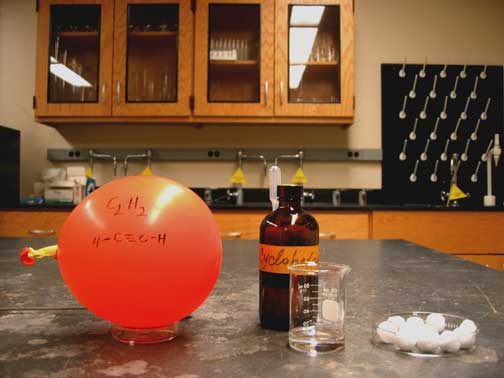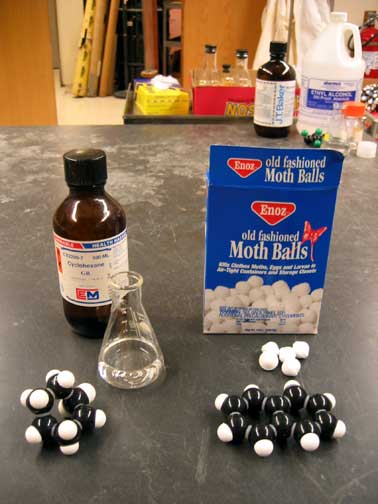London dispersion forces and the phases of hydrocarbons
 Compounds of hydrogen and carbon are observed to exist as gas, liquid or solid.
Compounds of hydrogen and carbon are observed to exist as gas, liquid or solid.
Ingredients: acetylene, cyclohexane, napthalene
Procedure: A complete recipe follows.
1. Acquire a balloon of acetylene gas, a beaker of cyclohexane liquid, and a plate of napthalene "moth balls."
2. Observe the systems using sight and smell.
Understanding: The compounds known as hydrocarbons exist in a variety of forms. All consist of a main "skeleton" of carbon atoms dressed with the "skin" of hydrogen atoms. The carbon atoms are connected by covalent bonds that may be single bonds, double bonds, or triple bonds. The hydrogen atoms are distributed about the molecule, each bringing one valence electron to form single bonds with carbon atoms in an attempt to complete the valence shell of each carbon atom in the molecule. That is the way we draw Lewis structures, and that is the way that the molecules come to be.
 In considering the attraction between hydrocarbon molecules, we know the molecules are neutral and nonpolar. The most important intermolecular attraction is the dispersion interaction. We ignore the hydrogen atoms and assume that the interaction of carbon atoms dominates the intermolecular interaction. We also assume that the dispersion interaction if similar between any two carbon atoms in the three molecules. We can now understand the three very different phases of matter that the hydrocarbons assume at room temperature and pressure.
In considering the attraction between hydrocarbon molecules, we know the molecules are neutral and nonpolar. The most important intermolecular attraction is the dispersion interaction. We ignore the hydrogen atoms and assume that the interaction of carbon atoms dominates the intermolecular interaction. We also assume that the dispersion interaction if similar between any two carbon atoms in the three molecules. We can now understand the three very different phases of matter that the hydrocarbons assume at room temperature and pressure.
Take the energy of attraction between any two carbon atoms to be on the order of 1 kJ/mol. Add up the number of carbon-carbon interactions you would expect to find between two acetylene molecules, two cyclohexane molecules, and two napthalene molecules. Now think of the thermal energy at room temperature that is roughly 2.5 kJ/mol. How does the energy of attraction compare with the thermal energy?
For acetylene with two interaction sites, we estimate the energy of attraction to be 2 kJ/mol which is much less than the thermal energy of 2.5 kJ/mol. And it's a gas! For cyclohexane with six interaction sites, we estimate the energy of attraction to be 6 kJ/mol which is close to the thermal energy, enough to hold the molecules together as a liquid. For napthalene with ten interaction sites we have 10 kJ/mol of attraction energy which is larger than the thermal energy. And napthalene is a solid!
The calculation is approximate, but it does tell us quite a bit about the reason we observe gas, liquid, or solid depending upon the size of the hydrocarbon molecule.
WANTED! Acetylene molecules for escaping from balloon
Question: You prepare to ignite a rubber balloon of acetylene gas. You tape the balloon to the wall and then remember that you need to run an errand. You return thirty minutes later and note that the balloon is smaller than before. You bring the flame to the balloon and find that it does not ignite! Thinking there may be a hole in the balloon, you fill the same balloon with air and find that it does not change in size when observed for several hours time. There is no hole! How did the acetylene escape from the balloon? Answer this question using your knowledge of molecular structure and intermolecular forces.
Quadruple bonds between carbon atoms? I don't think so!
Question:
Using the rules of Lewis structures, one can draw a structure for C2 that satisfies the octet rule and leaves each carbon atom with a filled valence shell. However, the molecule C2 does not exist with a quadruple bond between the two carbon atoms! Have we violated a rule of drawing good Lewis structures? What gives?